There are thousands of different steel compositions currently available around the world. To the beginner, the variety and terminology may at first be overwhelming. In fact, the way the steels are classified may be quite confusing even to the seasoned metallurgist. However, in many cases the steels fall into a limited number of well-defined classes. Many nations have their own classification systems. Because of the complexity of these different classification systems, only those used in the United States and also widely used in many other countries are described in this article.
Classification of Steels
Steels are generally classified by method of manufacture, use and chemical composition.
If steel is classified by method of manufacture, it gives rise to crucible steel. bessemer steel, open-hearth steel, basic oxygen steel and electric-furnace steel.
When steel is classified by use, it is generally classified by the final use for the steel such as machine steel, spring steel, boiler steel, structural steel or tool steel.
The easiest and the most popular way to classify steels are by their chemical composition. Various alloying elements are added to iron for the purpose of attaining certain specific properties and characteristics. These elements include, but are not limited to, carbon, manganese, silicon, nickel, chromium, molybdenum, vanadium, columbium (niobium), copper, aluminum, titanium, tungsten, and cobalt. A numbering system is used in classification by chemical composition method, giving information on the approximate content of the important alloying elements in the steel.
Classification Systems in USA
Three classification systems are used in USA as under.
The American Iron and Steel Institute (AISI) and Society of Automotive Engineers (SAE) System
For many decades, plain carbon and low-alloy steels have been classified by chemical composition using a system devised by SAE and eventually AISI.
The American Society for Testing and Materials (ASTM) System
ASTM system is not based on composition but is based on the steel product and application, for example, railroad rails, boiler tubes, plate, and bolts.
ASTM has very elaborate specifications for steels and cast irons. The specification for steels include the type of product (sheet, plate, bar, wire, rail, etc.), the composition limits, and the mechanical properties. The specification code consists of the letter “A†followed by a number. The ASTM system reaches far beyond ferrous materials and includes other materials also.
The American Society of Mechanical Engineers (ASME) devised a similar system, but it is generally limited to boiler and heat exchanger steels and other materials that are covered by the boiler code specifications. The ASME adopts the ASTM code and places “S†before it. For example, ASME SA213 shows that it is adopted from ASTM A213.
The Unified Numbering System (UNS)
Because of the confusion of different systems, a number of technical societies and U.S. governmental agencies devised what is known as the Unified Numbering System. There is a UNS designation for each steel composition, and it consists of a letter followed by five digits. The system fully incorporates the AISI/SAE system. For example, the UNS designation for AISI/SAE 1040 is G10400. The letter “G†represents the AISI/SAE plain carbon and alloy steels. Other ferrous alloys have different letters, such as “F†for cast irons and cast steels (cast steels can also have the letter “Jâ€), “D†for steels with specific mechanical properties, “S†for heat and corrosion resistant steels, “T†for tool steels, and “H†for steels with enhanced hardenability.
Generally information on the steels as classified simply by composition using the AISI/SAE system is given below. This system has been established for many years and is widely used in industry.
Classification of Steels by AISI/SAE Method
The alloy steels are generally divided into two classes, the low alloy steels and the high alloy steels. If alloying elements is less than 8 %, they are called low alloy steels and if alloying elements is more than 8 %, they are called high alloy steels. Classification of plain carbon steels, low alloy steels, high strength low alloy (HSLA) steels and a variety of other low alloy steels mainly as per AISI/SAE method (and ASTM system where appropriate) is described in the following sections.
American Iron and Steel Institute (AISI) together with Society of Automotive Engineers (SAE) have established four or five-numeral (with additional letter prefixes) designation system as under for carbon and low alloy steels.
The first digit indicates the type to which the steel belongs. Thus 1 indicates a carbon steel. 2 to 9 are used for alloy steels. For example, 2 for a nickel steel, 3 for a nickel-chromium steel and so on.
In case of carbon steels, the second digit indicates modification of the steel as under.
0 – Plain carbon, non-modified
1 – Resulfurized
2 – Resulfurized and rephosphorized
5 – Non-resulfurized, Mn over 1.0%
In the case of simple alloy steels, the second digit indicates the approximate percentage of the predominant alloying element (1 means 1%).
The last two or three digits usually indicate the mean carbon content divided by 100.
Thus the symbol AISI/SAE 1030 means non modified carbon steel, containing 0.30% of carbon and AISI/SAE 5130 means alloy chromium steel, containing 1% of chromium and 0.30% of carbon.
In addition to the numerals, AISI specification may include a letter prefix before the four-digit number to indicate the steel making process as under.
A – Alloy, basic open hearth
B – Carbon, acid Bessemer
C – Carbon, basic open hearth
D – Carbon, acid open hearth
E – Electric furnace
Thus AISI B1020 means non modified carbon steel, produced by acid bessemer process and containing 0.20% of carbon.
Within the AISI/SAE plain carbon steel designations there are five subclasses, namely 10xx, 11xx, 12xx, 13xx, and 15xx. These are broadly based on the following categories of steel composition:
| AISI/SAE designation | Type of steel |
|---|---|
| 10xx | Plain carbon: Mn 1.00% max |
| 15xx | Plain carbon: Mn 1.00–1.60% |
| 13xx* | Plain carbon: Mn 1.60–1.90% |
| 11xx | Plain carbon: resulfurized |
| 12xx | Plain carbon: resulfurized and rephosphorized |
* Actually, the 13xx series of steels is classified as low alloy steels because of the high manganese level. (Generally a steel with an alloying element content above 1.5% is considered a low alloy steel.) However, in the case of the 13xx series, one is basically dealing with a simple extension of the 10xx and 15xx plain carbon steels.
The AISI/SAE 15xx and 13xx series represent high manganese, plain carbon steels. The higher manganese levels impart higher hardness and strength to the steels.
The 11xx series of plain carbon, resulfurized steels contains intentionally added sulfur. The sulfur does not actually alloy with the iron but combines with manganese to form manganese sulfide (MnS) inclusions. The sulfur level is much higher in the 11xx series than the 10xx series of plain carbon steels where sulfur is generally considered as an impurity. The higher sulfur level in the resulfurized steels imparts improved machinability to the steel because of the chip-breaking effect of the manganese sulfides. An example of a resulfurized steel is AISI/SAE 1140 steel. For a given carbon content, the manganese levels are slightly higher in the 11xx series than in the 10xx series. The higher manganese levels compensate for the higher sulfur levels, because manganese is added to tie up all the sulfur to form manganese sulfides.
The AISI/SAE 12xx series represents resulfurized and rephosphorized, plain carbon steels that are also free-machining steels, with both sulfur and phosphorus additions. The phosphorus addition increases the strength of the steel and promotes chip breaking during machining operations. In order to limit the strength of the steel, the carbon content is restricted to a level under 0.15%.
The figure given below shows the microstructure of a typical resulfurized, rephosphorized steel containing manganese sulfides (the gray, oblong particles marked by arrows). The remaining microstructure is ferrite (white etching constituent) and pearlite (dark etching constituent).

The following table gives basic representation of the various grades of carbon and low alloy steels. Be sure to refer the most recent AISI and SAE publications for the latest revisions.
| AISI/SAE Specifications No. | Classifications |
|---|---|
| 10xx | Carbon steels |
| 11xx | Carbon steels, resulfurized |
| 12xx | Carbon steels, resulfurized and rephosphorized |
| 13xx | Manganese steels, 1.75% Mn |
| 2xxx | Nickel steels |
| 23xx | Nickel steels 3.50% Ni |
| 25xx | Nickel steels 5.0% Ni |
| 3xxx | Nickel chromium steels |
| 30xx | Ni-Cr steels 0.7% Ni, 0.7% Cr |
| 31xx | Ni-Cr steels 1.25% Ni, 0.6% Cr |
| 32xx | Ni-Cr steels 1.75% Ni, 1.0% Cr |
| 33xx | Ni-Cr steels 3.50% Ni, 1.50% Cr |
| 40xx | Carbon-molybdenum steels, 0.20 or 0.25% Mo |
| 41xx | Chromium-molybdenum steels |
| 43xx | Cr-Ni-Mo steels 0.50 or 0.80 Cr%, 1.83% Ni, 0.25% Mo |
| 46xx | Nickel-moly steels 1.65% Ni, 0.25% Mo |
| 48xx | Nickel-moly steels 3.25% Ni, 0.25% Mo |
| 50xx | Low chromium steels 0.40% Cr |
| 51xx | Medium chromium steels 0.80 to 1.00% Cr |
| 52xx | Carbon-chromium steels |
| 61xx | Chromium 0.60 or 0.95% – Vandium 0.13 or 0.15% min. steels |
| 86xx | Low Ni-Cr-Moly steels 0.55% Ni, 0.50% Cr, 0.20% Mo |
| 87xx | Low Ni-Cr-Moly steels 0.55% Ni, 0.50% Cr, 0.25% Mo |
| 92xx | Silicon-Manganese steels 2.00% Silicon |
| 93xx | Ni-Cr-Moly steels, 3.25% Ni, 1.20% Cr, 0.12% Mo |
| xxBxx | Boron steels (“B†denotes boron) |
| xxLxx | Leaded steels (“L†denotes lead) |
| 94Bxx | 0.45% Ni, 0.40% Cr, 0.12% Mo, 0.0005% Boron (min.) |
There are many low-alloy steels that are not classified under the above mentioned AISI/SAE system. Thus, the situation with low-alloy steels becomes much more complicated. For example, HY-80, a steel widely used for high-strength plate and forging applications, is a Ni-Cr-Mo steel but does not have an AISI/SAE designation. This particular steel is covered by a specification designation, ASTM A543. ASTM has dozens of specifications for low-alloy steels.
ASTM specifications also cover many of the low-alloy steels. However, as mentioned previously, the ASTM system is driven by the application for the particular steel. The system for low-alloy steels is quite large. For example, a fairly common low-alloy steel is 2¼ Cr-1Mo steel. In the ASTM system there are separate specifications covering this steel, depending on the product form that is manufactured, as shown below.
| Product Form | ASTM Designations |
|---|---|
| Forgings | A 182, A 336, and A 541 |
| Tubes | A 213 |
| Pipe | A 335 and A 369 |
| Castings | A 217 and A 356 |
| Plate | A 387 and A 542 |
As an example, ASTM A 213 has the title “Seamless Ferritic and Austenitic Alloy Steel for Boiler, Superheater, and Heat Exchanger Tubes.†The standard actually covers 14 different grades of ferritic steels and 14 different grades of austenitic steels. The 2 ¼ Cr-1Mo steel is grade T22. Because the grade is used in tubing for boilers and heat exchangers, it is also part of the specification system of ASME. The ASME code is SA213 type T22. The ASTM and ASME grade (type) T22 has the following composition.
Carbon: 0.15% max
Manganese: 0.30–0.60%
Silicon: 0.50% max
Chromium: 1.90–2.60%
Molybdenum: 0.87–1.13%
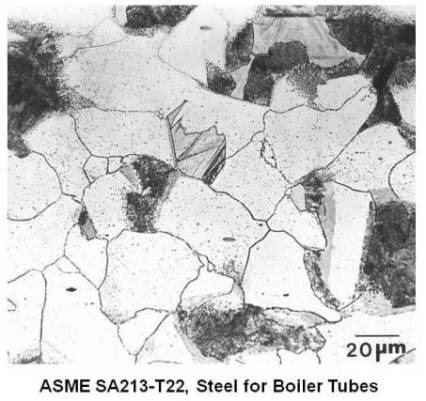
The microstructure of a typical ASTM A213 grade T22 steel (ASME SA213 type T22) is shown in the figure given above. The microstructure consists of ferrite (light etching constituent) and a small amount of pearlite (dark etching constituent). Light tan areas are martensite.
It is interesting to note that if the same steel was used for a forging or plate, it may have a different microstructure because of the different specified heat treatment. Even for tubes (ASTM A213), it can be furnished in the full-annealed, isothermal annealed, or normalized and tempered condition. Each condition would have a different microstructure.
Some representative standard-steel specifications for plain-carbon steel, free-machining steels and low alloy steels as per AISI/SAE grades are given in the following tables.
| Plain-Carbon Steels | ||||
|---|---|---|---|---|
| AISI/SAE Grade | % C | % Mn | % P max | % S max |
| 1010 | 0.08-0.13 | 0.30-0.60 | 0.04 | 0.05 |
| 1020 | 0.18-0.23 | 0.30-0.60 | 0.04 | 0.05 |
| 1030 | 0.28-0.34 | 0.60-0.90 | 0.04 | 0.05 |
| 1040 | 0.37-0.44 | 0.60-0.90 | 0.04 | 0.05 |
| 1045 | 0.43-0.50 | 0.60-0.90 | 0.04 | 0.05 |
| 1060 | 0.55-0.65 | 0.60-0.90 | 0.04 | 0.05 |
| 1070 | 0.65-0.75 | 0.60-0.90 | 0.04 | 0.05 |
| 1090 | 0.85-0.98 | 0.60-0.90 | 0.04 | 0.05 |
| Free-Machining Carbon Steels | ||||
|---|---|---|---|---|
| AISI/SAE Grade |
% C
|
% Mn | % P max | % S max |
| 1112 | 0.13 max | 0.70-1.00 | 0.07-0.12 | 0.16-0.23 |
| 1115 | 0.13-0.18 | 0.60-0.90 | 0.04 | 0.08-0.13 |
| 1140 | 0.37-0.44 | 0.70-1.00 | 0.04 | 0.08-0.13 |
| 1212 | 0.13 max | 0.70-1.00 | 0.07-0.12 | 0.16-0.23 |
| 1213 | 0.13 max | 0.70-1.00 | 0.07-0.12 | 0.24-0.33 |
| Alloy Steels | ||||||
|---|---|---|---|---|---|---|
| AISI/SAE Grade | % C | % Mn | % Ni | % Cr | % Mo | % V |
| 1330 | 0.28-0.33 | 1.60-1.90 | - | - | - | - |
| 2330 | 0.28-0.33 | 0.60-0.80 | 3.25-3.75 | - | - | - |
| 3115 | 0.13-0.18 | 0.40-0.60 | 1.10-1.40 | 0.55-0.75 | - | - |
| 4023 | 0.20-0.25 | 0.70-0.90 | - | - | 0.20-0.30 | - |
| 4130 | 0.28-0.33 | 0.40-0.60 | - | 0.80-1.15 | 0.15-0.25 | - |
| 4340 | 0.38-0.43 | 0.60-0.80 | 1.65-2.00 | 0.70-0.90 | 0.20-0.30 | - |
| 5140 | 0.38-0.43 | 0.70-0.90 | - | 0.70-0.90 | - | - |
| 6150 | 0.48-0.53 | 0.70-0.90 | - | 0.80-1.10 | - | 0.15 min |
| 8620 | 0.18-0.23 | 0.70-0.90 | 0.40-0.70 | 0.40-0.60 | 0.15-0.25 | - |
| 9260 | 0.56-0.64 | 0.75-1.00 | 1.80-2.20 | - | - | - |
| Note: For all grades, % P max = 0.035 and % S max = 0.04 | ||||||
Generally, carbon is the most important commercial steel alloy. Increasing carbon content increases hardness and strength and improves hardenability. But carbon also increases brittleness and reduces weldability because of its tendency to form martensite.
As per The American Iron and Steel Institute (AISI) a steel is considered to be a carbon steel when no minimum content is specified or required for chromium, cobalt, columbium [niobium], molybdenum, nickel, titanium, tungsten, vanadium or zirconium, or any other element to be added to obtain a desired alloying effect; when the specified minimum for copper does not exceed 0.40 per cent; or when the maximum content specified for any of the following elements does not exceed the percentages noted: manganese 1.65, silicon 0.60, copper 0.60.
Carbon steels are iron-carbon alloys containing up to 2.00% of carbon, up to 1.65% of manganese, up to 0.5% of silicon and sulfur and phosphorus as impurities.
Steels are sometimes classified by the broad range of carbon content as under.
Low-carbon steels: up to 0.30 percent carbon
Medium-carbon steels: 0.30 to 0.60 percent carbon
High-carbon steels: above 0.60 percent carbon
Low-carbon Steels
Often they are called mild steels. Low-carbon steels contain up to 0.30% C. The largest category of this class of steel is flat-rolled products (sheet or strip), usually in the cold-rolled and annealed condition. The carbon content for these high-formability steels is very low, less than 0.10% C, with up to 0.4% Mn. Typical uses are in automobile body panels (deep drawing parts), tin plate, and wire products. For rolled steel structural plates and sections, the carbon content may be increased to approximately 0.30%, with higher manganese content up to 1.5%. These materials may be used for stampings, forgings, seamless tubes, and boiler plate.
The figure given below shows the microstructure of a typical low-carbon steel (AISI/SAE 1010) showing a matrix of ferrite grains (white etching constituent) and pearlite (dark etching constituent).
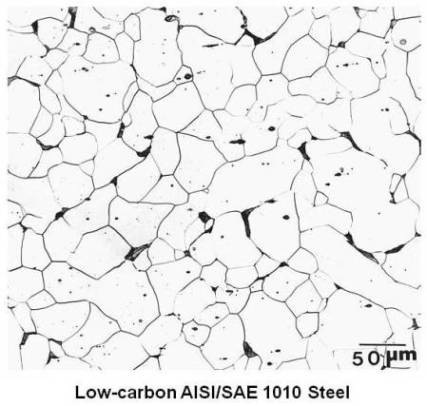
These steels are not hardenable by quenching and tempering as carbon content is less than 0.30 percent. In this type of steels, cold working is the principle hardening mechanism. They are relatively soft and weak due to pearlite and ferrite microstructures, but they are tough and ductile. They are easily formable, machinable, weldable and cheap.
AISI/SAE 1020, ASTM A36 (carbon steel shapes, plates and bars of structural quality for bridges, buildings and general structural purposes) and IS 2062 (Indian Standard on steel for general structural purposes) are examples of low carbon steels.
Chemical composition (maximum unless minimum is indicated) of mild steels made as per IS 2062 and ASTM A36 are as under.
| Steel Grades |
IS 2062 Gr A (Fe 410W A) |
IS 2062 Gr B (Fe 410W B) |
IS 2062 Gr C (Fe 410W C) |
ASTM A36 (plates and bars) |
|---|---|---|---|---|
| % C | 0.23 | 0.22 | 0.20 | 0.29 |
| % Mn | 1.50 | 1.50 | 1.50 | 1.20 |
| % Si | 0.40 | 0.40 | 0.40 | 0.04 |
| % S | 0.05 | 0.045 | 0.04 | 0.05 |
| % P | 0.05 | 0.045 | 0.04 | 0.04 |
| Carbon Equivalent | 0.42 | 0.41 | 0.39 | * |
* Minimum 0.2 % Cu when copper steel is specified
Medium-carbon Steels
Medium-carbon steels are similar to low-carbon steels except that the carbon ranges from 0.30 to 0.60% and the manganese from 0.60 to 1.65%. Increasing the carbon content to approximately 0.5% with an accompanying increase in manganese allows medium carbon steels to be used in the quenched and tempered condition. The uses of medium carbon-manganese steels include machine components, shafts, axles, gears, crankshafts, couplings and forgings. Steels in the 0.40 to 0.60% C range are also used for rails, railway wheels and rail axles.
The figure given below shows the microstructure of a typical medium-carbon steel (AISI/SAE 1040) showing ferrite grains (white etching constituent) and pearlite (dark etching constituent).
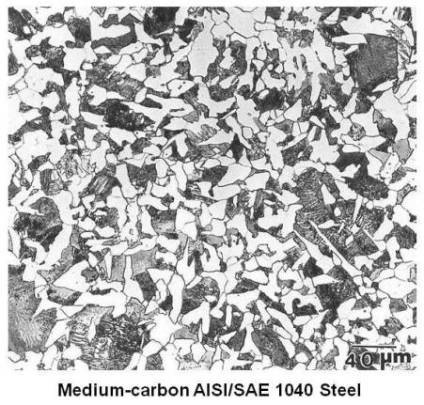
Mechanical properties of medium-carbon steels can be increased by heat treatment (by austenitizing or quenching & tempering). The rule of thumb is that 0.30 percent is the lower limit for hardening steel by heat treatment. However, plain carbon steels can be hardened only in thin sections with rapid quenching. Often there is distortion and cracking on quenching. They have poor impact resistance at low temperatures. To improve heat treating capabilities alloying elements like Cr, Ni, Mo, etc. are added to carbon steels and they are called alloy steels.
With 0.45 to 0.75 percent carbon, steels can be challenging to weld. Preheating, post heating (to control cooling rate), and sometimes even heating during welding become necessary to produce acceptable welds and to control the mechanical properties of the steel after welding.
High-carbon steels
High-carbon steels contain from 0.60 to 1.00% C with manganese contents ranging from 0.30 to 0.90%. They are hardest and strongest but least ductile. They are used in hardened and tempered state for wear resistance and cutting edges. They are used for spring materials, rope wires, screw drivers, hammers, wrenches, band saws, etc.
The figure given below shows the microstructure of a typical high-carbon steel (AISI/SAE 1095) showing a matrix of pearlite and some grain-boundary cementite.

A partial list of the plain carbon steels according to the ASTM specification system is given below to give an idea about classification of carbon steel as per ASTM specification.
| ASTM designation | Type of steel |
|---|---|
| A1 | Carbon steel, tee rails |
| A36 | Structural steel |
| A131 | Structural steel for ships |
| A228 | Steel wire, music spring quality |
| A307 | Carbon steel, bolts and studs, 420 MPa (60 ksi) tensile strength |
| A510 | Carbon steel wire rods |
| A529 | High-Strength Carbon-Manganese Steel of Structural Quality |
| A709 | Structural steel for bridges |
| A1011 | Steel, Sheet and Strip, Hot-Rolled, Carbon, Structural, High-Strength Low-Alloy, High-Strength Low-Alloy with Improved Formability, and Ultra-High Strength |
As examples, two of these ASTM specifications are described below in more detail.
ASTM A1 requires that railroad rails have certain composition limits and a minimum hardness. For example, for a common rail size of 60 kg/m (132 lb/yd) the requirements are as under.
Carbon: 0.72–0.82%
Manganese: 0.80–1.10%
Phosphorus: 0.035% max
Sulfur: 0.040% max
Silicon: 0.10–0.20%
Hardness: 269 HB min
The microstructure of a typical ASTM A1 rail steel is 100% pearlite.
ASTM A36 for structural steels is very different from ASTM A1 for rail steel in that it specifies only a maximum carbon content and certain tensile properties. ASTM A36 has the following requirements.
Carbon: 0.26% max
Yield point: 248 MPa (36 ksi) min
Tensile strength: 400–552 MPa (58–80 ksi)
Total elongation (in 50 mm, or 2 in.): 21% min
The microstructure of a typical ASTM A36 structural steel is a mixture of pearlite and ferrite, with some manganese sulfide stringers.
The ASTM specifications illustrated above are rather simple. As the product becomes more critical and the composition more complex, the requirements expand considerably.
High Strength Low Alloy (HSLA) Steels
Although many of the previously mentioned AISI/SAE low alloy steels also have high strength and, in some cases, ultrahigh strength (a yield strength above 1380 MPa, or 200 ksi), there is a rather loose class of steels called HSLA steels that do not fit the previously mentioned AISI/SAE classification.
These HSLA steels are a group of low and medium carbon steels that generally use small amounts of alloying elements to attain yield strengths usually above about 345 MPa (50 ksi) in the hot-rolled, cold-rolled, annealed, stress-relieved, accelerated-cooled, direct-quenched, or normalized condition. In some cases they are called microalloyed steels because of the small amounts of vanadium, columbium (niobium), and/or titanium that are added for grain refinement and precipitation strengthening.
High strength low alloy (HSLA) steels, or microalloyed steels, are designed to provide better mechanical properties and/or improved formability and greater resistance to atmospheric corrosion than conventional carbon steels.
They have low carbon contents (0.05-0.25% C) in order to produce adequate formability and weldability. In these steels small quantities of chromium, nickel, molybdenum, copper, nitrogen, vanadium, niobium, titanium and zirconium are used in various combinations.
Thus they have higher strengths, but still ductile, formable, machinable and generally more corrosion resistant. They are used for towers, bridges, columns, pressure vessels, etc.
ASTM specifies most of the HSLA steels according to composition, mechanical property requirements, and application. A partial list of ASTM specifications for various HSLA steels is given below.
| ASTM Designation | Type of Steel |
|---|---|
| A242 | HSLA Structural Steel |
| A572 | HSLA Columbium(niobium)-Vanadium Structural Steel |
| A588 | HSLA Structural Steel, up to 50 ksi [345 MPa] Minimum Yield Point, with Atmospheric Corrosion Resistance |
| A656 | Hot-Rolled Structural Steel, High-Strength Low-Alloy Plate with Improved Formability |
| A714 | HSLA Welded and Seamless Steel Pipe |
| A871 | HSLA Structural Steel Plate With Atmospheric Corrosion Resistance |
| A1008 | Standard Specification for Steel, Sheet, Cold-Rolled, Carbon, Structural, High-Strength Low-Alloy, High-Strength Low-Alloy with Improved Formability, Solution Hardened, and Bake Hardenable |
| A1011 | Steel, Sheet and Strip, Hot-Rolled, Carbon, Structural, High-Strength Low-Alloy, High-Strength Low-Alloy with Improved Formability, and Ultra-High Strength |
Within each ASTM specification, one can find the mechanical property requirements as well as the range of chemical composition allowed. There are numerous other ASTM specifications involving low-alloy steels, depending on the particular application.
Some HSLA steels have commercial trade names. Recent designations HSLA 80 and HSLA 100 are being used for steels of a very specific steel composition with a minimum yield strength level of 552 MPa (80 ksi) and 690 MPa (100 ksi). In reality, there can be many HSLA 80 and HSLA 100 steels, depending upon composition, thermomechanical treatment, and heat treatment.
Thus, there is not a standard classification system that encompasses all high-strength, low-alloy steels.
Chemical composition (maximum unless minimum is indicated) of HSLA steel made by SAIL Limited, Salem Steel Plant, India is as under.
| Steel Grades | SAILMA 350/350 HI, SAILMA 410/410 HI, SAILMA 450/450 HI |
| % C | 0.25 |
| % Mn | 1.5 |
| % Si | 0.4 |
| % S | 0.055 |
| % P | 0.055 |
| % Al | 0.01 min. |
| Micro alloying elements | Nb, V and Ti may be used individually or in combination, Nb + V + Ti – 0.2 % max. |
For comparison of steels (low-carbon and HSLA), mechanical properties of low-carbon steel (as per ASTM A36 and IS 2026) and high strength low alloy (HSLA) steel made by SAIL Limited, India are given below.
|
Steel Grades (Designation) |
Yield Strength N/mm2 |
UTS N/mm2 |
% El (min)+ | Bend Test (t)* |
Charpy V-Notch Impact Energy J (min) |
|---|---|---|---|---|---|
| ASTM A36 | 250 | 400-550 | 23 | - | - |
| IS 2062 Gr A (Fe 410W A) | 250 min | 410 min | 23 | 3t | - |
| IS 2062 Gr B (Fe 410W B) | 250 min | 410 min | 23 | 2t | 27 at 0° C |
| IS 2062 Gr C (Fe 410W C) | 250 min | 410 min | 23 | 2t | 27 at 0° C |
| SAILMA 350 | 350 min | 490-610 | 20 | 3t | 40 at 0° C |
| SAILMA 350 HI** | 350 min | 490-610 | 21 | 3t | 30 at -20° C |
| SAILMA 410 | 410 min | 540-660 | 19 | 3t | 35 at 0° C |
| SAILMA 410 HI** | 410 min | 540-660 | 20 | 3t | 25 at -20° C |
| SAILMA 450 | 450 min | 570-720 | 18 | 3t | 30 at 0° C |
| SAILMA 450 HI** | 450 min | 570-720 | 19 | 3t | 20 at -20° C |
* t = Nominal thickness of test piece
** HI – Denotes improved notch ductility
+ Gauge length = 2 in. for ASTM A36 and = 5.65 x (square root of S0) where S0 is the cross sectional area of test piece for IS 2062 and SAIL Limited products.
Other Low Alloy Steels
There are many low alloy steels that are not designed for just their room-temperature strength properties. These steels have additional properties that are important, such as corrosion or heat resistance and formability as under.
Low Alloy Steels for High-Temperature Properties
An example of a low alloy steel that is used for its high-temperature properties is ASTM A470 turbine rotor steel. These steels are used in steam turbines for electric power generation and usually contain combinations of nickel, chromium, molybdenum, and/or vanadium. The microstructure of ASTM A470 rotor steel consisting of tempered upper bainite is shown in the figure given below.
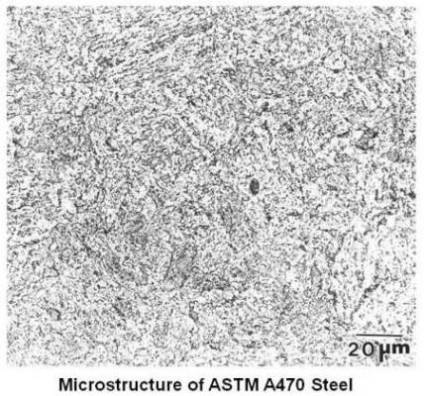
Low Alloy Steels for Improved Corrosion Resistance
There are a number of low alloy steels that have improved corrosion resistance. These steels usually have additions of copper, nickel, or chromium and are called weathering steels. The ASTM specifications cover several of these steels.
Low Alloy Steels with Formability
There are some steels that are designed for optimal formability in sheet-forming applications. One common steel is specified as drawing quality, special killed. This cold-rolled, low-carbon sheet steel has a specified aluminum content. The aluminum combines with nitrogen in the steel to form aluminum nitride precipitates during the annealing process. These aluminum nitride precipitates are instrumental in the development of a specific crystallographic texture in the sheet that favors deep drawing. Another type of steel used for applications requiring optimal formability is interstitial-free steel. In this very-low-carbon sheet steel, the interstitial elements, carbon and nitrogen, are combined with carbide- and nitride-forming elements, such as titanium and columbium (niobium). The steel is rendered “free†from these interstitial elements that degrade formability.
Bake Hardenable Low Alloy Steels
Specific sheet steels have been designed to increase strength during the paint-baking cycle of automobile production. These bake hardenable steels contain elements that develop compounds that precipitate at the paint-baking temperatures. These precipitates harden the steel.
Metals Classification
Metals can be classified in two main divisions as Ferrous metals (iron-based) and Non-ferrous metals (all the others) as shown below. It can be seen that classification of steels is a part of this classification.
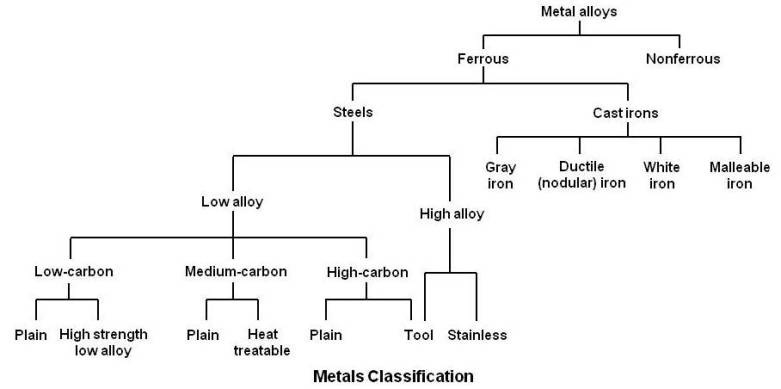
Information on effect of alloying elements on alloy steels, high alloy steels (stainless steels and tool steels) and cast irons is given in separate articles.
